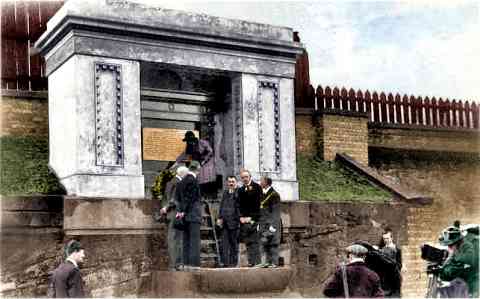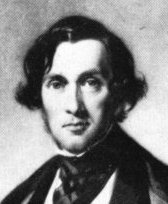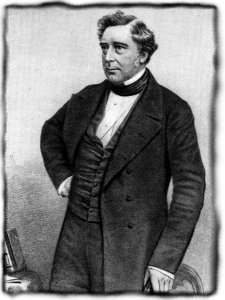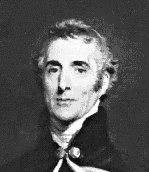This is the Monument that was placed beside the track, at the location of the accident, this photo is from the 1930 Centenary Memorial service

The Inscription on the Monument reads :
A mark of personal respect and affection has been placed here to mark the spot where, on the 15th of September 1830 at the opening of the railroad THE RIGHT HON. WILLIAM HUSKISSON M.P. singled out by an inscrutable Providence from the midst of the midst of the distinguished multitude that surrounded him, in the full pride of his talents and perfection of his usefulness met with the accident that occasioned his death, which deprived England of an illustrious Statesman and Liverpool of its honoured Representative, which changed a moment of noblest exultation and triumph that science and genius had ever achieved into one of desolation and mourning, and striking terror into the hearts of assembled thousands, brought home to every bosom for the forgotten truth that- In the midst of life, we are in Death
Here are some Contempory accounts of the accident from witnesss and papers of the day :
From Rocket 150 – 150th Anniversary of the Liverpool and Manchester Railway
What happened next is the subject of a variety of reports but it seems that William Huskisson, one of the Liverpool members of Parliament, crossed from his own carriage to speak to the Duke in his, possibly as part of the process of healing the strained relationship which had existed between the two men as a result of differing views on home and foreign policy. The Dukes carriage was standing on the south line, just Manchester sidc of the bridge and the first engine on the other line had gone forward to use the water column. Rocket was spotted moving forward to take its turn for water and those on foot scrambled out of thc way, either back into their carriages or to the lineside. The shouted warnings led Huskisson to take the same course and attempt to climb into the Dukes carriage after Prince Esterhazy had been helped up the narrow ladder. Huskissons companion, William Holmes, saved himself by remaining in the narrow gap between Rocket and the over-wide ceremonial saloon but Huskisson, who was not in the best of health, seemed confused by all the anxious shouting and appeared to lose both his grip on the door and his composure. Struck by either the locomotive or the door, he fell face downwards upon the ground and was unable to withdraw his left leg from across the rail with the result that the engine and some of the coaches mangled the unhappy politicians doubled up lower leg and thigh.
Huskissons injury was severe and although Doctor Brandreth and surgeon Hensman were among the guests, the trackside was no place to attend to an injured man. A tourniquet was applied to stem the bleeding, attempts made to console thc distraught Mrs Huskisson, and the MP placed upon a board and lifted to the low car used by the musicians. An engine was despatched to Manchester to summon further assistance and Northumbrian used to take the injured man forward to the home of the Rev. Mr Blackburne, the vicar of Eccles. Apart from attempts to ease the pain and to comfort the unfortunate gentleman, little could be done and, after the administration of the sacrament, hc expircd latcr in the day at the Eccles parsonage.
Naturally, this tragedy cast a cloud over the whole proceedings and, aftcr discussing the matter with Sir Robert Peel, the Duke wanted to cancel the remainder of the programme. Thc directors, on the other hand, felt that they had a commitmcnt to the public in gcneral and to their supporters in particular. The civic reprcsentatives of Manchester and Salford feared unrest at their end of the line if the vast crowds which lined the route for eight miles into Manchester were disappointed, and eventually the cavalcade resumed. But no music playcd and the exuberance of the celebrations was stilled, especially when a stop at Eccles brought news of Huskissons worsening condition.
Bangor, 19 September 1830
Jack Calcraft has been at the opening of the Liverpool rail road, and was an eye witness of Huskissons horrible death. About nine or ten of the passengers in the Dukes car had got out to look about them, whilst the car stopt [sic]. Calcraft was one, Huskisson another, Esterhazy, Bill Holmes, Birch and others. When the other locomotive was seen coming up to pass them, there was a general shout from those within the Dukes car to those without it, to get in. Both Holmes and Birch were unable to get up in time, but they stuck fast to its sides, and the other engine did not touch them. Esterhazy being light, was pulled in by force. Huskisson was feeble in his legs, and appears to have lost his head, as he did his life. Calcraft tells me that Huskissons long confinement in St Georges Chapel at the kings funeral brought on a complaint that Taylor is so afraid of, and that made some severe surgical operation necessary, the effect of which had been, according to what he told Calcraft, to paralyse, as it were one leg and thigh. This, no doubt, must have increased, if it did not create, his danger and [caused him to] lose his life. He had written to say his health would not let him come, and his arrival was unexpected. Calcraft saw the meeting between him and the Duke, and saw them shake hands a very short time before Huskissons death. The latter event must be followed by important political consequences. The Canning faction has lost its corner stone and the Dukes government one of its most formidable opponents. Huskisson, too, once out of the way, Palmerston, Melbourne, the Grants & Co. may make it up with the Beau [Wellington].
Mr Charles Granville wrote of the events :
It is a very odd thing, but I had for days before a strong presentiment that some terrible accident would occur at this ceremony, and I told Lady Cowper so, and several other people. Nothing could exceed the horror of the few people in London at this event, or the despair of those who looked up to him politically. It seems to have happened in this way:
While the Dukes car was stopping to take in water, the people alighted and walked about the railroad; when suddenly another car, which was running on the adjoining level, came up. Everybody scrambled out of the way, and those who could got again into the first car. This Huskisson attempted to do, but he was slow and awkward; as he was getting in some part of the machinery of the other car struck the door of his, by which he was knocked down. He was taken up, and conveyed by Wilton and Mrs. Huskisson (who must have seen the accident happen) to the house of Mr. Blackburne, eight miles from Heaton. Wilton saved his life for a few hours by knowing how to tie up the artery; amputation was not possible, and he expired at ten oclock that night. Wilton, Lord Granville, and Littleton were with him to the last. Mrs. Huskisson behaved with great courage. The Duke of Wellington was deeply affected, and it was with the greatest possible difficulty he could be induced to proceed upon the progress to Manchester, and at last he only yielded to the most pressing solicitations of the directors and others, and to a strong remonstrance that the mob might be dangerous if he did not appear. It is impossible to figure to ones self any event which could produce a greater sensation or be more striking to the imagination than this, happening at such a time and under such circumstances: the eminence of the man, the sudden conversion of a scene of gaiety and splendour into one of horror and dismay; the countless multitudes present, and the effect upon them-crushed to death in sight of his wife and at the feet (as it was) of his great political rival-all calculated to produce a deep and awful impression.
Chatsworth, September 27, 1830: . . . Lord Granville was just returned from Huskissons funeral at Liverpool. It was attended by a great multitude, who showed every mark of respect and feeling. He died the death of a great man, suffering torments, but always resigned, calm, and collected; took the Sacrament and made a codicil to his will, said the country had had the best of him, and that he could not have been useful for many more years, hoped he had never committed any political sins that might not be easily forgiven, and declared that he died without a feeling of ill-will and in charity with all men. As he lay there he heard the guns announcing the Duke of Wellingtons arrival at Manchester, and he said, “I hope to God the Duke may get safe through the day”. When he had done and said all he desired, he begged they would open a vein and release him from his pain.
 Joseph Locke | Joseph Locke was the Driver of “The Rocket” at the time of the accident.
Joseph Locke was born in Attercliffe, near Sheffield in 1805. He left school at 13 and after various jobs became an apprentice under George Stephenson in 1823. Locke worked with Stephenson on the building of the Stockton & Darlington Railway and the Liverpool & Manchester Railway. Lockes reputation grew and he was appointed with Stephenson as joint chief engineer of the Grand Junction Railway. Stephenson, who did not find it easy to share power with his former pupil and in 1835 decided to leave the project. |
| The Grand Junction Railway, opened on 20th July, 1837, was over eighty-two miles long and linked Birmingham with the Liverpool & Manchester line.The line included 100 underbridges, 50 overbridges, 5 viaducts, 2 tunnels and 2 aqueducts. On some parts of the line, Joseph Locke used double-headed rails held in chairs mounted on wooden sleepers. This proved to be very successful and this became the usual form of track on British railways for many years.
Locke developed a reputation for building straight railway lines that avoided expensive tunnelling. In doing so, he was forced in some places to adopt gradients that were too steep for economical running. However, he was the first railway engineer that realised that locomotives would gradually be able to overcome steep gradients. By the 1840s improved locomotives meant that Locke was able to build railway lines with gradients as steep as 1 in 50. Lockes success building the Grand Junction Railway resulted in him being offered commissions to build railways all over Europe, notably, the railway between Paris and Rouen. Joseph Locke died in 1860. | |
 Robert Stephenson (1803 – 1859) | Robert Stephenson, Had won the rainhill Trials with The Rocket engine that hit Mr Huskinson.
In 1823 Robert Stephenson joined with George Stephenson and Edward Pease to form a company to make locomotives. The Robert Stephenson & Company, at Forth Street, Newcastle-upon-Tyne, became the worlds first locomotive builder. To gain further experience, Robert went to Columbia in South America in 1824 where he worked at gold and silver mines. While in Columbia Robert Stephenson met the inventor, Richard Trevithick, and provided the funds that he needed to get back to Britain |
| After three years in South America, Stephenson was recalled to England and began work on the Rocket locomotive. Roberts abilities as an engineer was illustrated by the success of the Rocket at the Rainhill Trials in October, 1829. During this period Robert and George Stephenson were kept busy producing locomotives for the Bolton & Leigh Railway and the Liverpool & Manchester Railway. This included locomotives such as the Northumbrian and the Lancashire Witch.
In 1833 Robert Stephenson was appointed chief engineer of the London & Birmingham line. This was the first railway into London and involved solving difficult engineering problems such as the Blisworth Cutting and the Kilsby Tunnel. The London & Birmingham line was completed in 1838. For the next few years Stephenson was involved in constructing railways all over the world. He also built bridges, including those that crossed the Tyne at Newcastle and the Menai Straits. The Britannia Bridge at Conway was made up of two huge, rectangular, wrought iron tubes. Stephenson constructed a similar bridge over the St. Lawrence at Montreal, Canada (1854-59). For many years, this was the longest bridge in the world. In the 1847 General Election Stephenson was elected as the Conservative MP for Whitby. Stephenson did not take an active role in the House of Commons and usually only contributed to debates on engineering issues. Stephenson never enjoyed good health and early in 1859 he was advised to retire from business and politics. He took a yachting cruise but when he arrived in Norway his condition deteriorated and he was rushed back to England. Robert Stephenson died on 12th October, 1859. | |
 Arthur Wellesley, first Duke of Wellington (1769-1852) | The Duke of Wellington was one of the main reasons that Huskisson was out of his carriage and in harms way on the fatefull day, here in this potted history of Wellingtons Political carreer it explains the falling out that The Duke and Huskinson had previous to this meeting, and over which they seem to have shook hands before the accident occured. |
| On 22 January 1827 Wellington accepted the post of Commander-in-Chief of the British army but resigned when Canning became Prime Minister in April. He was reappointed by Goderich in August 1827 and then became Prime Minister in his own right on 22 January 1828. When it was realised that he was still Commander-in-Chief there was a public outcry and he was forced to resign that position.
Wellingtons Tory government was defeated in the House of Commons when MPs voted in favour of repealing the Test and Corporation Acts. In February 1828 Wellington decided to pass the legislation himself, a measure in diametric opposition to traditional Tory Crown, Church and Constitution policies. The next month Wellingtons President of the Board of Trade introduced legislation for a sliding scale on corn duties which was passed without amendment. Huskisson MP refused to vote with the government and resigned, precipitating the County Clare election that led ultimately to the passing of the Catholic Emancipation Act on 13 April 1829. However, before the legislation passed, the Duke fought a duel with Lord Winchilsea over the issue of Catholic Emancipation: both men deloped and honour was deemed to be satisfied. Wellington also took the opportunity of Huskissons resignation to remove all the other Canningites who were in his Cabinet. Once he was out of office, Wellington was appointed as Commander-in-Chief of the army, a post that he held until his death, which took place suddenly at Walmer Castle on 14 September 1852. He lay in state there until 10 November and then in Chelsea Hospital until 17 November. He was given a state funeral and was buried in St. Pauls Cathedral. He was 83 years old. | |



